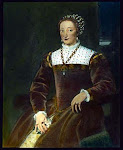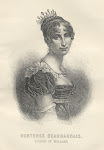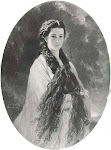
Saturday, October 27, 2007
Wednesday, October 24, 2007
A Day in the Life...

Have you ever wondered what it would be like to spend a day in the life of a Queen? Or a princess? I have. I'm sure you're not surprised at that! But...let's sort of follow her around for a day...and kind of hang out. Of course, the kind of day she'd have would vary from country to country and from decade to decade. And then again, there are Queens in their own right, and Queen Consorts, which are Queens that are married to a reigning King. A Queen in her own right might be Maria Theresa of Austria--the mother of Marie Antoinette. She reigned and worked. A consort would be a Queen such as Queen Charlotte, who married the reigning monarch Mad King George.
.
.
The Queen might be awakened by a maid or lady in waiting, and served a tray of tea or coffee, perhaps with fruit, and she might sit up and read the papers. The drapes would be opened, and after a time, her clothes for the day would be brought in (or a selection of clothes). If she was staying in the palace for the day, and no visitors were coming, she might slip into a pretty dress, but nothing too formal. She would be assisted in her dressing by a maid. The Queen would also sit down at her dressing table and would begin her toilette, which we would call 'putting on our face.' The Queen would be assisted with any makeup she might wear and her hair would be done for her. Hair ornaments would also be added, and a few jewels...perhaps a necklace and earrings.
.
.
After that, she would be accompanied by a lady in waiting to the dining room for breakfast. Oh, did you think the coffee and fruit was breakfast? Oh, no. The King might accompany her as well. A footman would open the dining room door for her, and another uniformed footman would pull out her chair. If she had children and they were old enough they might join their parents for breakfast, and sometimes a senior lady in waiting would be invited to stay to dine. If there was a private secretary and a royal doctor, they also might be invited. It varied day to day.
.
.
After a leisurely breakfast, the Queen would return back to her sitting room or office and begin her work. If she was a reigning Queen, she would be assisted by her personal secretary and usually her senior lady in waiting...
.
.
As far as ladies are concerned, all ladies that assisted the queen were called "Ladies in Waiting" although there was a hierarchy of ladies. The senior one might be called "A Mistress of the Robes" and the next senior might be "Lady of the Bedchamber." Then there were assistant ladies of the bedchamber, maids of honor, etc. The senior lady in waiting would see that the Queens wishes were taken care of. If the Queen needed to appoint a lady in waiting, the Mistress of the Robes would send the letter to the lady in question. She would handle the matter and let the Queen know the details. The Mistress of the Robes acted as sort of a secretary. If the Queen wanted to see someone in the palace, a senior lady would tell a lesser ranking lady, and the person would be fetched. Also, ladies worked for a month or two at a time, and then returned to their families. At any given time there was usually between 4 to 8 ladies at court. Some kept the Queen company, and might read with her, and often the ladies chosen were noble ladies, such as Duchesses or Countesses...or women who were used to court life. It was also a plus is they could paint or draw, ride, sing, play an instrument or speak a second language.
.
.
During her morning she would sign official documents, read important news and letters, dictate or write responses, and sometimes receive visitors. Her private secretary would give her the work in order of it's importance and usually had comments of his own to clarify the situation for her. Sometimes he might make suggestions.
.
.
After a long morning of work, it would be time for luncheon. Again, she would be accompanied to the dining room, or if it was nice weather lunch might be laid out on a private terrace. One or two of the Queens ladies would eat with her--after all--they were there to keep her company. Luncheon wasn't usually too heavy. In the royal household, though, every meal was served on fine plates and the food arranged beautifully.
.
.
After eating, the Queen might be ready for a break. She might wish to take the air. (That's what they called sitting outside or taking a carriage ride throughout the grounds). Fresh air and light exercise were always recommended. If the weather wasn't fair, she would retire again to her sitting room area, and perhaps read her personal correspondence...the royals were very fond of letter writing. They couldn't be too familiar with many and so it meant a lot to them to commit their feelings to paper and send them off by a special courier to their relatives. Some couriers regularly went to other countries and some delivered the royal letters to recipients inside the country. She might do some needlepoint, drawing or read by the fireplace. Sometimes in the afternoon they were visited informally, or they received visitors formally. There might be a meeting arranged, or even an afternoon drawing room. Lucky for today, the Queen has none of those!
.
.
Before dinner, there would always be some time to rest. The Queen might be visited by some of her children or her husband...or sometimes lie down on her chaise. A lady in waiting might read to her, or the Queen might want quiet time. While she enjoyed some quiet time, the servants were busy getting things ready for...dinner.
.
.
Her evening dresses would be brought into her dressing area for her to look at. At the appropriate time, she would go to her dressing table and begin her toilette again. Her toilette would be different for dinner. Her hair might be piled high on her head, letting tendrils fall, and jewels might be added to her hair, and for larger dinners with many guests a tiara would be chosen. (And tiara's do hurt, ladies!) The Queen might do some adjusting here and there...but her lady would do her hair and jewels. Then she would be helped into the dress most appropriate, which was usually a formal one with much lace, ruffles or beading, made of the finest fabric. (All her clothes were made just for her, and hand stitched.)r
.
.
For all intents and purposes, we'll say that tonight will be a small dinner...just family and a few quests. The more senior servants would join them, and so their party might consist of 10 or 12 people. The King and Queen...or the Queen and her consort would assemble outside the dining room, and the family, guests and servants would line up according to precedence. Once assembled, the door would be opened and they would take their appropriate places, according to rank and precedence. If it was a larger dinner, some guests might already be seated.
.
.
Courses were many. Candelabras were lit, and fine china was laid out. Tables were adorned with flowers and sometimes menu's. It would be appropriate to talk to the guest on your left and your right, giving equal time to each. Dinners were formal, and etiquette was stiff. Footman usually watched the Monarch, and once he or she was done with a course, they would begin taking away the dishes...to the dismay of some. If the Monarch was a fast eater--and some were--you were out of luck, and so you learned to eat fast!
.
.
After dinner amusements were just as stiff as dinner. Guests would retire to the drawing room for cards, games and conversation. The Queen would mingle throughout the room, making sure she spoke to each person for a short bit...and she would speak to them first. Talk about the weather or riding or a person's general health were proper topics. A guest would never say, "I heard you had terrible stomach pains the other day. How do you feel?" That would be quite improper. They might say something like this: "I had heard Your Majesty was feeling indisposed earlier this week. I do hope you are recovered." And even that would be a bit too familiar! Only those close to her would say something like that. So, conversation was generic and polite.
.
.
Sometimes there might be a band and dancing at the palace, depending on the amount of visitors that evening. On other nights, there might be a performance by a singer, or a concert or play given. They also attended the opera on some nights. They did have balls and grand balls, too...but for tonight we'll keep them close to 'home'.
.
.
If the Queen was having a wonderful, gay time, she might be inclined to stay up later than usual. No matter how tired the guests were--and the Ladies in Waiting--they would not retire until she did. Once the Queen (and her husband) left, often there would be sighs of relief, and guests would plop down on a couch or chair, tired, with painful feet! Being invited to dine with the Crown was an honor indeed...however, because there were such firm rules of etiquette, it could be quite grating on the nerves! Guests were known sometimes to slip away into another room to sit down for a bit! Remember if the Queen stood, so did everyone else. If the Queen was sitting, the others could too. Some courts were stiff and boring and long...others were more relaxed and gay.
.
.
Back in her bedchamber, she would be assisted with undressing and her dresser would take care of putting her precious jewels back in their safe place. Her hair might be brushed, too. If she was keyed up and not tired, she might want to read for awhile or ask a lady to read to her. Sometimes the Queen might pen a letter or write in her journal, or dictate a letter to her lady. A fire would be lit, too, to keep the Queen warm during the night.
Alone in her bed (with fluffy pillows and thick quilts) the Queen would blow out her candle at the bedside and lay down. Invariably, she would think about the day past, and more importantly, the day ahead. Nothing was left to chance. Each day and week and month were planned in advance and rarely was there anything spontaneous on the menu. The Queen might be excited about the next day...perhaps they would be traveling to a favorite vacation home. Or maybe it was something more tedious....like a levee or drawing room or even a ball! Some of these things could be trying. The Queen would have to stand on her feet for a long period of time, or, shake a thousand hands easily. But, everyday was something different.
.
.
Hopefully, the Queen would have sweet dreams and be looking forward to something the next day! She is Queen after all, and so she shall make sure it is so! She will decree it! Her eyes would get heavy and she would relax. Sleep would come soon.
And YOU! You're only a visitor who's been graciously allowed a peek into her day! So, I think it's time to leave the Queen's bedchamber now!........Quietly, please......
Subscribe to:
Comments (Atom)
















+Mary++Princess+of+OrANGE.jpg)



































.jpg)







.png)




























